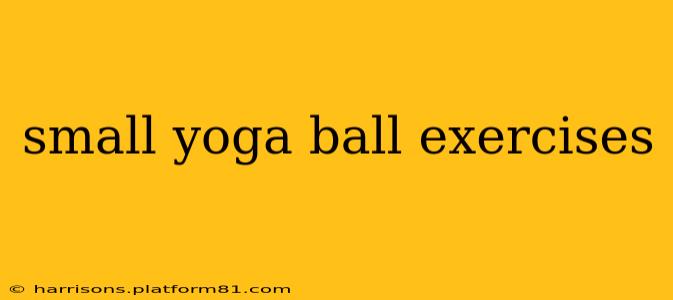A small yoga ball, also known as a stability ball or fitness ball, is a versatile and affordable piece of equipment that can significantly enhance your workout routine. Its instability forces your core muscles to engage constantly, leading to improved balance, strength, and flexibility. Whether you're a seasoned fitness enthusiast or just starting your fitness journey, incorporating small yoga ball exercises into your routine can provide a fun and effective way to achieve your fitness goals. This guide will explore various exercises, addressing common questions and providing detailed instructions.
What are the benefits of using a small yoga ball?
Using a small yoga ball offers a multitude of benefits beyond just a fun workout. The instability it creates challenges your balance and stability, forcing your core muscles to work harder to maintain your posture. This leads to:
- Improved Core Strength: The constant engagement of your core muscles is key to strengthening your abdominal muscles, back muscles, and obliques. A stronger core provides better posture, reduces back pain, and improves overall body stability.
- Enhanced Balance: The unstable surface of the ball requires constant adjustments, improving your proprioception (body awareness) and balance. This is particularly beneficial for older adults or individuals prone to falls.
- Increased Flexibility: Certain exercises, like stretches and twists, can be performed on the ball to increase flexibility and range of motion in various muscle groups.
- Variety in Workouts: The small yoga ball allows for a wider variety of exercises compared to traditional floor exercises, making your workout more engaging and preventing boredom.
- Low-Impact Workout: Many small yoga ball exercises are low-impact, making them suitable for individuals with joint problems or injuries.
What are some easy small yoga ball exercises for beginners?
For beginners, it's crucial to start with simple exercises and gradually increase the intensity and duration as your strength and balance improve. Here are a few easy exercises:
Seated Ball Balance:
Simply sit on the ball and maintain your balance. Focus on engaging your core muscles to keep your posture upright. Start with short intervals and gradually increase the time as you improve your balance.
Ball Roll-Outs:
Kneel in front of the ball, placing your hands on the ball. Slowly roll the ball forward, extending your arms, and then roll it back to the starting position. This exercise works your core and shoulders.
Wall Sits (with Ball Support):
Lean your back against a wall and place the yoga ball between your lower back and the wall. Perform a wall sit, ensuring your core is engaged to maintain stability.
Hamstring Stretches on the Ball:
Lie on your back with your legs extended, and place your heels on top of the ball. Pull your legs towards your chest, gently stretching your hamstrings.
What are some more advanced small yoga ball exercises?
Once you've mastered the basic exercises, you can progress to more challenging movements:
Plank with Ball Support:
Perform a plank position, but place your forearms on the ball instead of the floor. This increases the challenge by engaging more core muscles and improving stability.
Ball Push-Ups:
Place your hands on the ball shoulder-width apart. Perform push-ups, focusing on maintaining core engagement throughout the movement. This variation is more challenging than traditional push-ups due to the instability.
Ball Crunches:
Lie on your back with your feet on the ball. Perform crunches, engaging your core muscles to lift your upper body off the floor. The ball adds resistance, making it a more effective core workout.
Leg Raises (with Ball Support):
Lie on your back with your heels on the ball. Slowly raise your legs towards the ceiling, engaging your core muscles to maintain stability. Lower your legs slowly back to the starting position.
Are there any small yoga ball exercises that can help with back pain?
Certain small yoga ball exercises can help strengthen your core and improve your posture, potentially alleviating back pain. However, it is crucial to consult with a healthcare professional or physical therapist before starting any new exercise program, particularly if you have pre-existing back pain. Some exercises that may be beneficial include:
Pelvic Tilts:
Lie on your back with your knees bent and feet flat on the floor. Place the yoga ball between your lower back and the floor. Gently tilt your pelvis forward and backward, feeling the movement in your lower back.
Cat-Cow Pose (on the ball):
Kneel on the floor with the yoga ball under your chest. Perform a cat-cow pose, moving your spine in a gentle, flowing motion. This helps to increase flexibility and mobility in your spine.
Spinal Twists (on the ball):
Sit on the ball with good posture. Gently twist your torso to the right and left, feeling the stretch in your back muscles.
Remember, always listen to your body and stop if you feel any pain.
What are some precautions I should take when using a small yoga ball?
- Choose the right size: Select a ball that is appropriate for your height and weight.
- Start slowly: Begin with basic exercises and gradually increase the intensity and duration.
- Maintain proper form: Focus on maintaining proper posture and form throughout each exercise to prevent injuries.
- Engage your core: Remember to engage your core muscles to maintain balance and stability.
- Consult a professional: If you have any underlying health conditions, consult with a healthcare professional before starting any new exercise program.
By following these guidelines and incorporating small yoga ball exercises into your routine, you can experience the numerous benefits of this versatile piece of fitness equipment and enhance your overall fitness level. Remember consistency is key, so aim for regular use to maximize your results.
